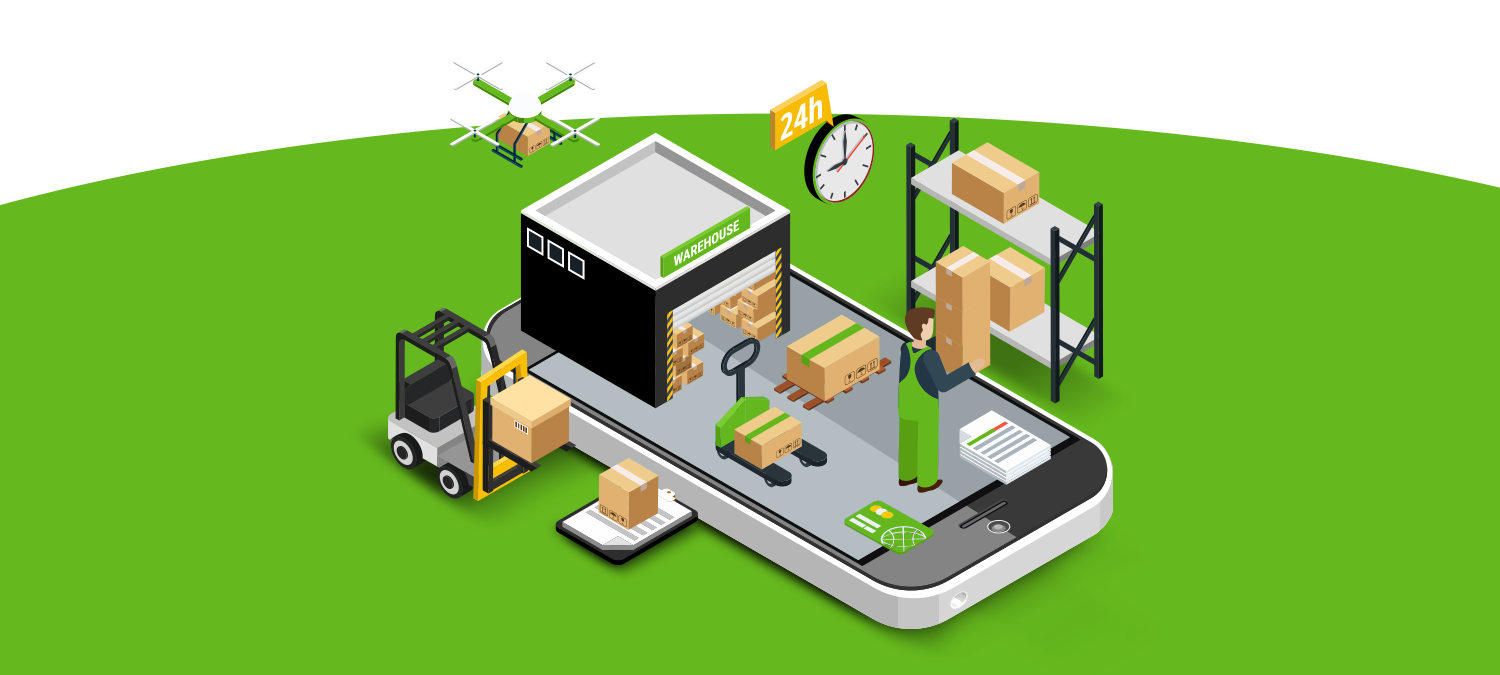In 2023, ecommerce continues to rapidly evolve. Worldwide, there are already up to 24 million online stores, ranging from startups to ecommerce giants like Amazon.
Given the growing competition and heightened expectations of online consumers, the warehouse processes of such companies require increased attention. Ecommerce warehouse management differs from managing a traditional warehouse. It directly influences the level of customer service and their willingness to make repeat purchases.
And if you are reading these lines, chances are your online business has already outgrown your home warehouse, and you are considering ways to optimize your warehouse processes. In our article, we will explain what ecommerce warehousing is, highlight the importance of proper warehouse organization, and provide a modern solution for its efficiency.
- What is Ecommerce Warehousing?
- Organized Ecommerce Warehousing: Why Is It Important?
- What Types of Warehouses Can Meet the Needs of An Online Business?
- How to Manage An E Commerce Warehouse?
- The Role of WMS in Efficient Ecommerce Warehousing
- Conclusion
- Frequently Asked Questions
What is Ecommerce Warehousing?
Ecommerce warehousing is the process of storing goods intended for sale through online platforms. It goes beyond the physical placement of products on shelves. It is a systematic approach to managing all inventory to efficiently process orders, reduce costs, and meet the needs of online customers.
Organized Ecommerce Warehousing: Why Is It Important?
The importance of proper ecommerce warehouse management cannot be underestimated. It directly influences customer satisfaction, operational efficiency, and the financial performance of the business.
On average, ecommerce companies spend 70% of the order value on fulfillment. This is quite a significant amount, reaffirming the importance of organized ecommerce warehousing. A properly organized warehouse can reduce costs and bring many other benefits, including:
- Fast order processing: Organized ecommerce warehousing enables quick order processing. This is crucial as customers expect swift delivery.
- Improved inventory management: Precise placement of goods and systematic inventory control reduce the risk of shortages or excess stock.
- More efficient logistics: Organized warehousing processes contribute to improved logistics. They impact the optimization of delivery routes and the management of transportation resources.
- Improved customer service: Reduced delivery times and minimized order errors lead to increased customer satisfaction and growth in their loyalty.
- Time and resource savings: Organized processes require less time and effort to accomplish tasks, resulting in resource savings and reduced operational costs.
- Scalability flexibility: Well-organized warehousing systems easily scale with business growth, providing flexibility and efficient management of increasing order volumes.
What Types of Warehouses Can Meet the Needs of An Online Business?
The term “ecommerce warehouse” refers to a facility or a complex of facilities where you store your inventory for storage. The development of online commerce has directly influenced the formats of such spaces. All of them provide different opportunities for optimizing warehouse processes and meet the specific needs of a particular business. If you are a newcomer to this segment or plan to expand, you will need to understand them.
Public warehouses
Public warehouses are often government-operated storage facilities available for rent to various companies. Their advantage lies in the ability to rent only the amount of space you need. This means you can easily scale its usage according to your requirements.
Warehouses of this type can also be used for temporary storage. This is particularly useful for startups and companies that experience seasonal fluctuations in demand.
Government-owned warehouses
Government warehouses are state-owned and are typically used to store strategically important reserves. They may also provide storage services for private companies. Generally, warehouses of this type can ensure high security standards. This can be crucial for businesses storing valuable goods or items with special storage conditions, such as food products or medical supplies.
However, when using government warehouses, it’s important to consider the rules and restrictions set by the relevant authorities.
Private warehouses
Private warehouses are owned by private companies or entrepreneurs. They can be used for storing the owner’s inventory or leased to other businesses. The owners of such warehouses can customize them to suit the specific needs of their own business or the business of the tenant. This includes different storage solutions, security systems, or temperature controls.
The use of a private warehouse is also associated with expenses related to rent or construction, maintenance, and security. To make an informed decision about the necessity of using a private warehouse for ecommerce, evaluate your needs and resources beforehand.
Cooperative warehouses
Cooperative warehouses represent a form of collaboration among multiple companies for the shared utilization of warehouse space and logistical resources. This model enables enterprises to collaboratively address storage, inventory management, and delivery issues.
An additional advantage of such warehouses is the collective utilization of resources, such as equipment and technologies. This reduces the investment burden on each participant in warehouse infrastructure and enhances the efficiency of shared space utilization.
It is important to note that the effectiveness of cooperative warehouses depends on how well the collaboration processes between companies are organized.
Consolidated warehouses
A consolidated warehouse is a logistics center where goods from various suppliers are combined into a “consolidated shipment.” This type of warehouse involves the control, sorting, and distribution of goods to form consolidated shipments. A consolidated warehouse enables ecommerce companies to reduce delivery costs.
However, it is important to note its main drawback. The shipment of a container occurs only when it is fully loaded. Take this into account to minimize potential delays and ensure the efficiency of the overall logistics chain.
Bonded warehouses
Customs warehouses are designed for the temporary storage of goods subject to customs control. They allow for the completion of necessary customs formalities before the final shipment of goods. Such warehouses are particularly crucial for companies engaged in international shipping.
Fulfillment centers
Fulfillment centers are ecommerce warehouses managed by third-party service providers (3PL). They encompass not only storage areas for goods but also workstations for their packaging, labeling, and preparation for shipping.
Fulfillment centers provide ecommerce companies with the opportunity to outsource key logistical processes, avoiding the need to maintain their own warehouse spaces. Startups or medium-sized businesses looking to circumvent the complexities of warehouse management can benefit from renting their services. Additionally, larger companies struggling with growing order volumes may also choose to utilize fulfillment centers.
Smart warehouses
Smart warehouses are modern storage facilities that extensively incorporate advanced technologies and automation systems. These may include robots for the movement and sorting of goods, as well as storage systems relying on large volumes of data for precise inventory management.
Smart warehouses are better scalable to handle large volumes of goods. Their technology solutions meet the needs of large companies. Smart warehouse capabilities enable companies to grow efficiently and adapt changing market conditions.
How to Manage An E Commerce Warehouse?
Dynamic demand is characteristic of online business. This requires warehouses to be flexible and scalable. To meet the growing demand and consumer expectations, you need a well-thought-out strategy.
The ecommerce warehouse management encompasses a broad spectrum of strategic, technological, and analytical aspects, including:
- Development and training of e commerce warehouse staff.
- Accurate inventory management and the use of technologies for monitoring and controlling warehouse equipment.
- Optimization of interaction with suppliers and carriers to build an efficient supply chain.
- Implementation of safety measures in the process of storing and moving goods.
- Forecasting delivery volumes and anticipating demand for labor resources.
- Obtaining and maintaining all necessary certificates and licenses.
- Developing strategies to scale warehouse operations in accordance with business growth.
- Implementation and adherence to safety regulations to protect personnel.
- Thorough tracking and monitoring of inventory movement to maintain up-to-date data on stock levels.
- Adapting to the specificity of the business, including managing returns, integrating new technologies, and continually improving processes.
Only by paying attention to all aspects of ecommerce warehouse management can you reduce fulfillment costs and meet your customers’ need for fast delivery.
The Role of WMS in Efficient Ecommerce Warehousing
Modern shoppers expect quick order confirmation, instantaneous inventory deduction, and equally fast delivery. If you apply outdated methods for the ecommerce warehousing management, meeting their needs can be challenging. Manual management may lead to errors, delays, and unnecessary expenses.
Warehouse Management System (WMS) is the right solution for ecommerce companies seeking to enhance the efficiency of warehouse operations. Its functions and capabilities contribute to process optimization and can ensure effective management of warehouse space.
Advantages of an automated warehouse management system for ecommerce include:
- Accurate product tracking: WMS provides precise and systematic tracking of products, allowing for information on the location of each item in the warehouse. This reduces the risk of errors and facilitates the retrieval and processing of goods.
- Warehouse space optimization: A warehouse management system can automatically determine the optimal placement of goods in the warehouse, taking into account their characteristics and demand. This contributes to the maximum efficiency of space utilization.
- Accuracy and speed in order fulfillment: WMS automates order picking processes, enhancing accuracy and speeding up order fulfillment. This is particularly crucial in e-commerce, where rapid order processing and delivery are essential.
- Efficient returns management: WMS simplifies returns management processes. It enables the efficient redistribution of goods back into the inventory system and ensures a prompt refund process.
- Integration with ecommerce platforms: The warehouse management system seamlessly integrates with ecommerce platforms, facilitating the automatic transfer of data about orders, inventory, and delivery status.
- Maximum labor productivity: Warehouse management systems automate tasks and optimize employee work schedules. This allows you to maximize the efficient use of labor resources and reduce costs.
- Reporting and analytics: The system provides detailed reports and analytical information about warehouse operations. This helps you make informed decisions, improve processes, and optimize operations.
- Responsiveness to changes: WMS ensures flexibility in adapting to changes in demand, seasonal fluctuations, and other factors.
Conclusion
Ecommerce warehousing is an integral and strategically important component for the successful operation of online businesses. Given the dynamic nature of ecommerce, proper management of warehouse processes becomes a key factor for accurate and swift order fulfillment.
Investing in modern approaches to ecommerce warehouse management is a necessary step for the successful development of online businesses. Technological solutions with integrated Warehouse Management Systems (WMS), such as Ysell.pro, can help optimize current operations and provide additional opportunities for the growth of online businesses.
Successful optimization of an ecommerce warehouse will not only meet the needs of existing customers but also attract new ones. You will be able to reduce operational costs and adapt to dynamic market changes, which is crucial for the development of an e-commerce business.
Frequently Asked Questions
1. What is the difference between inventory management and ecommerce warehouse management?
Inventory management focuses on controlling levels of goods, their ordering, and storage considering supply and demand. Ecommerce warehouse management includes a broader range of tasks such as order processing, warehouse space optimization, and ensuring an efficient logistics chain.
2. What are the main challenges faced by ecommerce warehousing and how to overcome them?
Challenges in ecommerce warehousing include increased order volumes, seasonal fluctuations, managing returns, and the need for fast delivery. Overcoming them requires modern technologies and the use of analytics for more accurate demand forecasting and inventory optimization.
3. What is the difference between a traditional warehouse and an ecommerce warehouse?
Entrepreneurs most often use a traditional warehouse to store goods in large quantities for mass distribution. In contrast, an ecommerce warehouse is focused on the rapid processing of individual orders, minimizing delivery times, and ensuring a high level of service for online shoppers.
4. What factors should be considered when choosing the type of warehouse for ecommerce?
When choosing the ecommerce warehouse, one should consider sales volumes, the type and characteristics of goods, delivery time requirements, budget constraints, and unique business needs.







